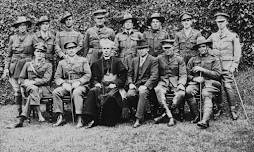The Rogue, the Archbishop and the Shamrocks
 |
| John Wren (1871-1953) AWM P01383.018 |
In his 1990 contribution to the Australian Dictionary of Biography, James Griffin describes John Wren as an entrepreneur. More recently, Melbourne Murder Tours chose to label Wren as a Victorian Gangster and a prominent member of the Pony Track Gang. Australian author, Frank Hardy, having published his fictionalised account of John Wren's life in the novel Power Without Glory, found himself in court being sued by the Wren Family. Apparently, the fictionalised version was too close for comfort.
Whatever the truth is around the nature and conduct of Wren's business activities, there appears to be little doubt that he was a strong Irish Catholic and benefactor of the poor. He was involved in gambling, the owner of race tracks and race horses, a boxing promoter, newspaper owner, land speculator and much more. He was wealthy and had some influence in political circles.
 |
| Daniel Mannix (1864-1963) Australian Dictionary of Biography |
Mannix was appointed as Archbishop of Melbourne in 1912, arriving to an approving welcome in the Easter of 1913. With the outbreak of war in 1914, Mannix drew attention as an opponent of Billy Hughes' conscription referendum and was sympathetic to the sentiments behind the 1916 Easter Rising in Ireland. It was also during the war years that he gained the friendship and support of a prominent local Irish Catholic businessman, John Wren.
 |
| "Raheen", Melbourne |
 |
| "Studley House", Melbourne |
It is at this point that our narrative must give mention to the 1918 St Patrick's Day celebrations in Melbourne. In March 1918 the war was still raging, particularly on the Western Front, and the Easter Rising in Ireland of 1916 was still fresh and raw to those of Irish Catholic heritage. To others, the Rising was a treacherous and treasonable act, justly suppressed by the British. Of course, it would have been obvious that an Irish Catholic parade celebrating an Irish Catholic saint was going to have symbols referencing the 1916 Rising, and it did. Reports indicate that Sinn Fein flags and other "seditious and treasonable emblems" had been a strong feature of the Parade. The Dubbo Liberal and Macquarie Advocate of Tuesday, March 26, 1918, had much to say on the topic and was baying for the blood of Dr Mannix:
"The growing feeling of unrest and irritation caused throughout the Commonwealth by the seditious utterances of Dr Mannix.....culminated in Melbourne on Thursday in a citizens' demonstration of protest in the Melbourne Town Hall.......Scattered about among the audience were a few women who wore Sinn Fein colours openly, while some well-known representatives of the Peace Society were also there. Ill feeling ran high, and women armed with hat-pins, to which were attached the Sinn Fein colours, attempted to stab other women. Numbers were forcibly removed..."
The Lord Mayor of Melbourne, totally blind-sided by the unexpected display of "disloyal" emblems, was not in the least disposed to grant permission for the next St Patrick's day march in 1919. His position was simplified, in a manner of speaking, with the return of troops and, with them, the arrival of the Spanish Flu. The 1919 St Patrick's march did not happen! The 1920 procession, however, was a totally different story!
The 1920 St Patrick's Day parade was to be one of the first, perhaps even the first, large public gathering in Melbourne since the end of the war. The flu epidemic was over and the majority of troops had returned home.. There was cause to have a celebration and John Wren was determined that St Patrick's Day would do the job.
Plans to hold the parade were strongly opposed by groups such as The Ulster & Loyal Irishmen's Association and the Women's National League and strong representations were made to the City Council to ban the parade. Wren, with a typical stroke of genius, formed a Parade Committee strongly laced with veterans and Victoria Cross recipients, one of whom was Maurice Buckley.
"Wren and his Parade Committee promised that there would be no disloyal display or official recognition of Sinn Fein and assured the Council that the British flag would be at the head of the display.
Maurice Buckley VC DCM was a member of the committee and made a remarkable gesture. Referring to his Victoria Cross he said: 'This cross is my most treasured possession, yet I will pledge it to you now that we will abide by your ruling loyally.' The Lord Mayor, Cr Aikman, replied: 'Your gesture satisfies me that loyal and true Australians will take part in the celebrations.'
Perhaps what was more important to Buckley and his comrades was the knowledge that veterans of the war would be marching together for the first time since the end of the war. More than 10,000 veterans marched in the parade, watched by 120,000 cheering supporters lining the route." (History Teachers Association of Victoria - Agora magazine 2020 - full article here)
 |
| 12 VC's with Mannix & Wren. Buckley is standing directly behind and between Mannix & Wren |
 |
| The parade in progress |
The parade was a resounding success, made all the more memorable by the spectacle of Mannix and Wren waving royally from an open limousine and escorted by 14 Victoria Cross recipients, all mounted on magnificent white horses. As promised, there were no disloyal displays. However, one report suggests that a casual observer would have had some difficulty seeking out a British flag.
 |
| Maurice Buckley's funeral procession |





No comments:
Post a Comment